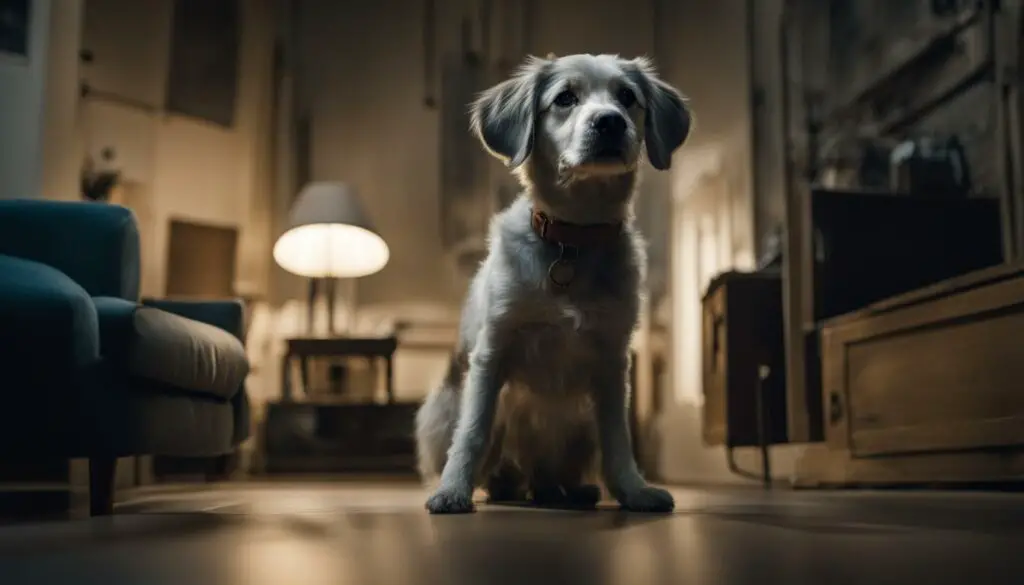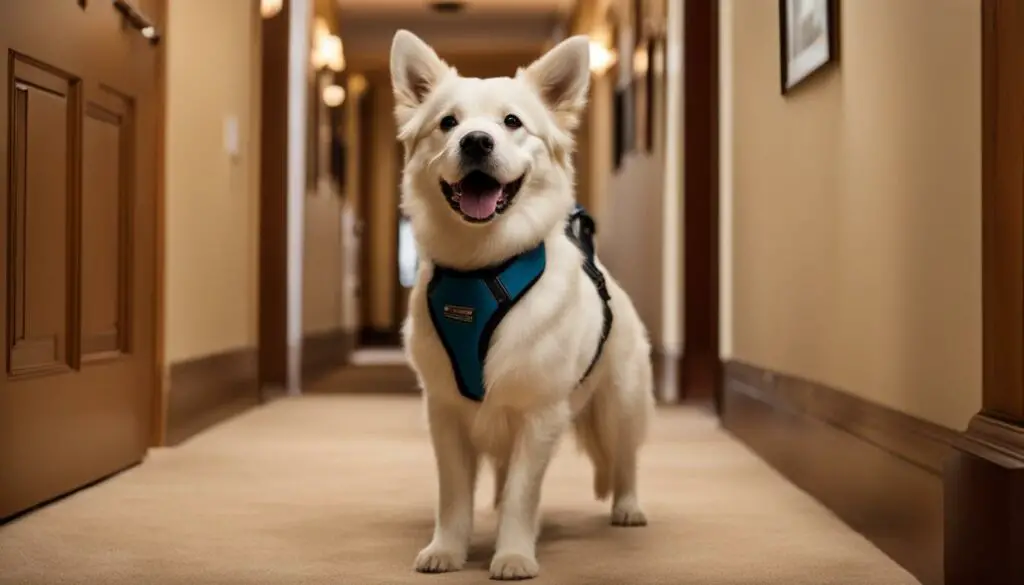Making the decision to euthanize a blind and deaf dog can be a difficult and heartrending choice. In this compassionate guide, I will explore when it may be the right time to consider this option.
Key Takeaways:
- Deciding when to euthanize a blind and deaf dog is a deeply personal decision based on their quality of life and overall well-being.
- Recognizing the signs of canine dementia in blind and deaf dogs is crucial for managing their health.
- Consulting with a veterinarian is essential for diagnosing and managing canine dementia in blind and deaf dogs.
- Monitoring the decline in quality of life can help guide the decision to euthanize a blind and deaf dog.
- Seeking emotional support and professional guidance is important during this challenging time.
Signs of Canine Dementia in Blind and Deaf Dogs
Canine dementia, also known as canine cognitive dysfunction (CCD), is a common condition that affects many senior dogs, including those who are blind and deaf. It is important to recognize the signs of dementia in order to effectively manage the health of a blind and deaf dog.
Some common signs of canine dementia include:
- Pacing
- Appearing lost
- Acting confused
- Changes in behavior towards family members or other pets
- Restlessness
- Loss of interest in previously enjoyed activities
These signs may vary from dog to dog, but if you notice any of these behaviors in your blind and deaf dog, it is important to consult with a veterinarian for proper diagnosis and guidance.

Early recognition of canine dementia can help in implementing appropriate management strategies to improve the quality of life for your furry companion. By addressing these signs, you can provide your blind and deaf dog with the support and care they need as they navigate this challenging condition. Consulting with a veterinarian is essential in ensuring the well-being of your beloved pet.
Diagnosing Canine Dementia in Blind and Deaf Dogs
Diagnosing canine dementia in blind and deaf dogs can be a challenging task, as there is no specific test for this condition. However, your veterinarian can make a diagnosis based on the symptoms exhibited by your dog. It is important to consult with your vet if you suspect that your blind and deaf dog may be showing signs of dementia. They will be able to evaluate your dog’s overall health and behavior to determine if dementia is the underlying cause.
During the diagnosis process, your vet may conduct a thorough physical examination and assess the dog’s medical history. They may also take into consideration any changes in behavior, such as disorientation, confusion, or altered interactions with family members or other pets. It is crucial to provide your vet with detailed information about your dog’s symptoms and behaviors, as well as any relevant medical history, to aid in the diagnosis.
Additionally, your veterinarian may recommend further tests or evaluations to rule out other potential causes of your dog’s symptoms. These tests can include blood work, neurological exams, and imaging studies. While these tests may not definitively confirm canine dementia, they can help eliminate other possible causes and provide further evidence to support a diagnosis.
Recognizing the Signs of Canine Dementia:
- Pacing
- Appearing lost
- Acting confused
- Changes in behavior towards family members or other pets
By being vigilant and observant of these signs, you can play an essential role in helping your veterinarian diagnose canine dementia in your blind and deaf dog. Remember, early detection and intervention can greatly improve your dog’s quality of life and overall well-being.
Managing Canine Dementia in Blind and Deaf Dogs
The management of canine dementia in blind and deaf dogs requires a comprehensive approach to ensure their well-being and quality of life. By implementing various strategies, pet owners can help alleviate the symptoms and provide comfort to their beloved companions.
One effective method is to establish a predictable routine for the dog. This includes consistent feeding, exercise, and rest times. Maintaining a regular schedule can help reduce confusion and anxiety, promoting a sense of stability for the dog.
Mental stimulation is also crucial in managing canine dementia. Providing interactive toys, puzzle games, and supervised walks can engage the dog’s mind and help slow cognitive decline. These activities stimulate brain function and prevent boredom, contributing to the overall well-being of the dog.
In addition to routine and mental stimulation, reinforcing familiar commands is essential. Teaching and practicing basic commands can help the dog feel more secure and confident. This can include commands such as “sit,” “stay,” and “come.” Consistent repetition of these commands can help the dog retain learned behaviors and improve their daily interactions.
Furthermore, veterinarians may recommend supplements, medications, or special diets to support brain health in blind and deaf dogs with dementia. These interventions aim to slow the progression of the disease and alleviate symptoms. It is important to consult with a veterinarian to determine the most appropriate options for the individual dog’s condition.

Table: Recommended Strategies for Managing Canine Dementia in Blind and Deaf Dogs
| Strategies | Benefits |
|---|---|
| Establish a predictable routine | Reduces confusion and anxiety |
| Provide mental stimulation through toys and walks | Engages the dog’s mind and slows cognitive decline |
| Reinforce familiar commands | Increases the dog’s sense of security |
| Consult with a veterinarian for supplements, medications, or special diets | Supports brain health and slows disease progression |
Recognizing a Decline in Quality of Life
As our blind and deaf dogs age, it is important to monitor their quality of life closely. Recognizing signs of a decline can help guide us in making decisions regarding their care and well-being. Some indicators that our blind and deaf dogs may be experiencing a decline in their quality of life include:
- Frequent accidents: Increased difficulty in controlling their bodily functions may be a sign that they are struggling.
- Restlessness: If our dogs seem unable to settle and are constantly pacing or wandering aimlessly, it may indicate agitation or discomfort.
- Confusion: Acting disoriented or appearing lost in familiar surroundings can be a clear indication of cognitive decline.
- Extreme anxiety: Our dogs may exhibit heightened levels of anxiety, such as panting, trembling, or excessive whining.
- Loss of interest: A decrease in enthusiasm for activities and interactions that were once enjoyable may suggest a loss of pleasure.
Monitoring these signs and discussing them with our veterinarian can help us determine if it may be time to consider making the difficult decision to euthanize our blind and deaf dogs. It is important to approach this decision with compassion and do what is best for their overall well-being.

Making the Difficult Decision: When to Euthanize a Blind and Deaf Dog
Making the decision to euthanize a blind and deaf dog is undoubtedly one of the hardest choices a pet owner may have to face. It is a decision that requires careful consideration, empathy, and a deep understanding of your furry companion’s well-being. When determining the best time to euthanize a blind and deaf dog, there are several factors to take into account to ensure the most compassionate choice is made.
First and foremost, it is crucial to assess your dog’s quality of life. Consider whether they are experiencing more pain, discomfort, or distress than moments of joy and contentment. Evaluate their ability to engage in activities they once enjoyed and whether their overall health is deteriorating. Remember, the goal is to prevent any unnecessary suffering and provide them with a peaceful passing when their quality of life is compromised.
Consulting with your veterinarian is essential during this difficult time. They can provide professional guidance and offer insights into your dog’s specific condition and prognosis. Your vet will consider factors such as their medical history, current symptoms, and any potential treatment options. Together, you can discuss their expert opinion and make an informed decision that prioritizes your dog’s well-being above all else.
Remember that deciding to euthanize a blind and deaf dog is an act of selfless love. It allows them to find peace and freedom from their pain and suffering. While the decision may be incredibly challenging, know that you’re making the best choice for your beloved companion.
Throughout this decision-making process, it’s essential to lean on your support system. Share your thoughts and emotions with loved ones who understand and empathize with your situation. Seeking counseling or support groups for pet owners facing similar circumstances can also provide a safe space to express your feelings and find solace in shared experiences.
Ultimately, the decision to euthanize a blind and deaf dog is a deeply personal one. Trust your instincts and the love you have for your furry friend. Remember the beautiful moments you shared and the unwavering bond you developed. By making the difficult decision to say goodbye, you are ensuring their final moments are filled with love, dignity, and an end to their suffering.
Understanding the Emotional Impact
Deciding to euthanize a blind and deaf dog is an incredibly difficult and emotional decision. It is normal to feel a range of intense emotions during this process, including grief, guilt, and sadness. The bond we share with our furry companions is incredibly strong, and saying goodbye can be one of the hardest things we ever have to do.
It’s important to remember that choosing euthanasia is a selfless act of kindness. By making this difficult decision, we are putting our dog’s well-being and quality of life above our own desires to keep them with us. It’s a way to end their suffering and allow them to be at peace.
“Saying goodbye to our blind and deaf dogs is an act of love and compassion, even though it may be one of the hardest things we ever have to do.”
During this emotional journey, it’s essential to seek support from loved ones who understand the depth of your bond with your blind and deaf dog. Friends, family members, and even support groups can provide a safe space for you to express your feelings and find solace in shared experiences. Consider reaching out to pet loss counselors who specialize in helping individuals cope with the loss of a beloved pet.
Remember, grieving is a natural process, and there is no timeline for healing. Allow yourself to feel the emotions and take the time you need to honor the love and joy your blind and deaf dog brought into your life. Cherish the memories and find comfort in knowing that you gave your furry friend the best life possible.

The Emotional Impact of Euthanizing a Blind and Deaf Dog
The decision to euthanize a blind and deaf dog is never easy. It is filled with emotional turmoil, as we grapple with the loss of a beloved companion and the responsibility of determining their end-of-life care. Understanding the emotional impact of this decision is crucial to navigating this difficult time.
Guilt is a common emotion that arises during the decision-making process. We may question if we did enough for our dog or if we should have made different choices along the way. It’s important to remember that we are making this decision out of love and compassion, prioritizing our dog’s well-being above our own desires to keep them with us.
Grief is another powerful emotion that accompanies the loss of a blind and deaf dog. The bond we share with our pets is unique, and saying goodbye can be incredibly painful. It’s essential to give ourselves permission to grieve and seek support from loved ones who understand the depth of our loss.
Remember that you are not alone in this journey. Reach out to pet loss support groups or consider talking to a counselor who specializes in pet bereavement. They can provide guidance, understanding, and a safe space to process your emotions.
Seeking Professional Support
When facing the difficult decision of euthanizing a blind and deaf dog, it is crucial to seek professional support to navigate through this emotional journey. Pet loss counselors and support groups can provide invaluable guidance, understanding, and a safe space to process your emotions.
These professionals specialize in helping individuals cope with the loss of a beloved pet and can offer advice on coping mechanisms, self-care practices, and ways to memorialize your blind and deaf dog. They understand the unique bond you shared with your furry companion and can provide the necessary support to help you navigate this challenging time.
Support groups can connect you with others who have experienced similar situations, allowing you to share your feelings and experiences with those who truly understand. This sense of community can provide comfort, reassurance, and validation as you work through your grief.
“Grieving the loss of a blind and deaf dog is a natural and individual process. Seek support from friends, family, or pet loss support groups to help navigate the emotions and find healing during this difficult time.” – Anonymous
Remember, seeking professional support does not diminish your love for your blind and deaf dog, nor does it mean you are weak. It is a courageous step towards healing and finding solace in the midst of heartache. The professionals are there to provide the necessary tools and resources to help you honor the memory of your beloved companion while finding a sense of peace.

Take the time to reach out, connect with others who can offer understanding and support, and allow yourself to grieve. Through professional assistance and the support of your loved ones, you can navigate this difficult time and find healing, honoring the beautiful life and unconditional love of your blind and deaf dog.
Home Euthanasia for a Blind and Deaf Dog
When the time comes to make the difficult decision to euthanize a blind and deaf dog, opting for home euthanasia can provide a more comfortable and familiar environment for their final moments. Many veterinary hospice services offer in-home euthanasia, allowing you and your dog to be in the comfort of your own home during this difficult time.

Home euthanasia can help reduce stress for both you and your dog. It eliminates the need for transportation to a veterinary clinic, which can be challenging for blind and deaf dogs who may feel disoriented or anxious in unfamiliar settings. Being in a familiar environment surrounded by their favorite toys, bed, and familiar scents can help provide comfort and peace during their last moments.
In addition to the emotional benefits, home euthanasia also allows you to have more control over the process. You can choose the time and place that feels right for you and your dog. You can create a calm and serene atmosphere, playing soft music, dimming the lights, and surrounding your dog with loved ones. It allows for more privacy and intimate moments of saying goodbye.
Ultimately, the decision of whether to opt for home euthanasia for your blind and deaf dog is a personal one. It is essential to consider what will provide the most comfort and support for your dog during this time. Discussing your options with a veterinarian and exploring the services offered by veterinary hospice can help you make an informed decision that best honors your dog’s life and final moments.
Deciding When It’s Time: HHHHHMM Scale
When considering the difficult decision of when to put down a blind and deaf dog, the HHHHHMM scale can be a valuable tool. This scale assesses various aspects of your dog’s well-being, helping you evaluate their quality of life. By considering factors such as hurt, hunger, hydration, hygiene, happiness, mobility, and more, you can gain insight into their overall condition.
Using the HHHHHMM scale involves assigning a score to each category, typically ranging from 0 to 10, with 0 being the worst and 10 being the best. By thoroughly evaluating each aspect, you can gain a comprehensive understanding of your dog’s current state. For example, if your blind and deaf dog is experiencing significant pain, has a poor appetite, and is unable to move comfortably, these factors may indicate a decline in their quality of life.
In addition to the individual scores, it’s essential to consider the overall pattern and trend of your dog’s well-being over time. If you notice a consistent decline across multiple categories and your dog’s overall score remains consistently low, it may be an indication that their quality of life is diminishing. However, it’s important to consult with your veterinarian for their professional assessment and guidance, as they have the expertise to evaluate your dog’s condition.
Remember that the decision to euthanize a blind and deaf dog is deeply personal and should always prioritize the well-being and comfort of your beloved companion. The HHHHHMM scale can provide valuable insights, but it should be used as a tool to inform your decision rather than a definitive measure. Ultimately, trust your instincts, consult with your veterinarian, and consider your dog’s overall quality of life when determining the best time to say goodbye.
| Category | Score |
|---|---|
| Hurt | |
| Hunger | |
| Hydration | |
| Hygiene | |
| Happiness | |
| Mobility | |
| Overall Score |
Trusting Your Gut Feelings
When it comes to making the difficult decision of when to put down a blind and deaf dog, it is essential to trust your instincts and gut feelings. As the owner, you have a deep understanding of your dog’s personality, behavior, and overall well-being. Take the time to reflect on their quality of life and how they are coping with their condition.
Consider your blind and deaf dog’s daily experiences, such as their mobility, appetite, and interaction with their environment. Watch for signs of pain, discomfort, or distress. If you notice a significant decline in their physical or mental health, it may indicate that their suffering is becoming too great.
Remember, you are their voice and advocate. Although it is a heartbreaking decision, choosing euthanasia can be an act of love and compassion, ensuring they are at peace and free from pain. Seek guidance from your veterinarian, who can provide valuable insights and support throughout this decision-making process.

Trusting Your Instincts
Trusting your instincts is crucial when deciding the best time to euthanize your blind and deaf dog. While there is no one-size-fits-all answer, your intuition can guide you in understanding their needs and well-being. Pay attention to your emotional connection with your dog and trust your judgment.
Remember that making this decision is deeply personal, and there is no right or wrong choice. Each dog is unique, and what works for one may not work for another. Seek support from friends, family, or support groups who have experienced similar situations to help you navigate through this challenging time.
Ultimately, you know your dog better than anyone else. Trusting your gut feelings can provide you with a sense of peace, knowing that you have made the best decision possible for your beloved blind and deaf companion.
Understanding the Role of Emotions
When faced with the decision of when to euthanize a blind and deaf dog, it is crucial to acknowledge the role of emotions in the decision-making process. Emotions can cloud judgment and make it difficult to distinguish between our own feelings and what is truly best for our beloved companion.
During this challenging time, it is essential to seek support from trusted friends, family members, or professionals who can provide guidance and lend a listening ear. Talking through your emotions and concerns with others can help bring clarity and provide a different perspective on the situation.
Additionally, considering counseling or therapy can be beneficial in navigating through the intense emotions that come with this decision. Professionals trained in pet loss and grief can offer valuable support and help you process your feelings of grief, guilt, and sadness.
Remember, it is normal to experience a range of emotions when faced with the end-of-life decision for your blind and deaf dog. By seeking support and allowing yourself to grieve, you can find solace and healing as you honor the unconditional love and bond you shared with your beloved companion.
A Last Act of Kindness: Saying Goodbye
Saying goodbye to our beloved blind and deaf dogs is one of the most challenging decisions we may face as pet owners. However, euthanasia can be an act of kindness and a final gift we can give to end their suffering and provide them with a peaceful passing.
When the time comes to say goodbye, it is important to ensure that our blind and deaf dogs are as comfortable as possible. Opting for home euthanasia can create a more familiar and calming environment for their final moments. Many veterinary hospice services offer in-home euthanasia, allowing you and your dog to be in the comfort of your own home during this difficult time.
“Euthanasia is often viewed as a last act of kindness and a final gift we can give to our beloved blind and deaf dogs.”
It is natural to experience a wide range of emotions during this process, including grief, guilt, and sadness. Remember that choosing euthanasia is a selfless act of love to end your dog’s pain and allow them to be at peace. Seek support from loved ones, friends, or professional counselors who can provide guidance and a safe space to process your emotions.
As we say goodbye to our furry friends, it is important to honor their memory and the unconditional love they brought into our lives. Take the time to grieve and find healing through memorializing your beloved blind and deaf dog. Reflect on the joy they brought and the bond you shared, knowing that you made a compassionate choice to end their struggles and provide them with a gentle farewell.

Table: In-Home Euthanasia Services Comparison
| Service Provider | Cost | Availability | Additional Services |
|---|---|---|---|
| Vet Hospice A | $200 | 24/7 | Pet bereavement counseling |
| Vet Hospice B | $250 | Weekdays only | Cremation arrangement |
| Vet Hospice C | $150 | Weekends and evenings | Home burial guidance |
Finding Support and Healing
Grieving the loss of a blind and deaf dog is a natural process that requires support and understanding. Connecting with others who have experienced similar loss can provide comfort and solace during this difficult time. Pet loss support groups offer a safe space to share your feelings, memories, and challenges with individuals who can empathize with your unique journey.
These support groups provide a non-judgmental environment where you can openly express your emotions and receive validation for your grief. They can also offer guidance on coping strategies and provide resources for healing. In addition to support groups, consider reaching out to friends, family, or a therapist who can offer a listening ear and emotional support.
Memorializing your blind and deaf dog can be a helpful part of the healing process. Creating a tribute, such as a photo collage, a memorial garden, or a personalized keepsake, can provide a tangible reminder of the love and joy your dog brought into your life. Reflecting on the happy memories and celebrating your dog’s life can bring a sense of closure and peace.
Resources for Pet Loss Support:
- Pet Loss Support Hotline: A confidential phone service that provides compassionate support and guidance for those grieving the loss of a pet. Call toll-free at 1-888-743-7888.
- The Association for Pet Loss and Bereavement: An online resource offering support and information to help individuals cope with the loss of a pet. Visit their website at www.aplb.org.
- Local Animal Shelters or Veterinary Clinics: Many shelters and clinics offer pet loss support groups or can provide recommendations for local resources.

| Support Group | Location | Contact Information |
|---|---|---|
| Paws to Remember | New York, NY | www.pawstoremember.com |
| Healing Hearts Pet Loss Support Group | Los Angeles, CA | www.healinghearts.com |
| Forever Friends Pet Loss Support | Chicago, IL | www.foreverfriendspetsupport.com |
Conclusion
Deciding when to euthanize a blind and deaf dog is a challenging and emotional decision. It requires careful consideration of your dog’s quality of life and overall well-being. Consulting with your veterinarian can provide invaluable guidance during this difficult time.
Remember that choosing to euthanize your beloved companion is an act of love and compassion. It allows them to be free from pain and suffering, providing them with a peaceful and dignified end of life. Seeking support from friends, family, or pet loss support groups can help you navigate the grieving process and find healing.
Take the time you need to grieve and honor the unconditional love and bond you shared with your blind and deaf dog. Trust your instincts and reflect on their well-being when making this challenging decision. Remember that you are making the best choice for their quality of life and overall happiness.
Finally, know that you are not alone. Many others have faced similar decisions and emotions when it comes to the end of life for their blind and deaf dogs. Seek support, allow yourself to grieve, and hold onto the beautiful memories of the love and joy your companion brought into your life.
FAQ
When is the right time to consider euthanizing a blind and deaf dog?
The right time to consider euthanizing a blind and deaf dog is when their quality of life declines significantly, they experience frequent accidents, restlessness, extreme anxiety, confusion, and a loss of interest in previously enjoyed activities.
What are the signs of canine dementia in blind and deaf dogs?
Signs of canine dementia in blind and deaf dogs may include pacing, appearing lost, acting confused, and changes in behavior towards family members or other pets.
How is canine dementia diagnosed in blind and deaf dogs?
Canine dementia in blind and deaf dogs is diagnosed based on the symptoms they exhibit. There is no specific test for CCD, so it is important to consult with your veterinarian if you suspect your dog may have dementia.
How can I manage canine dementia in my blind and deaf dog?
To manage canine dementia in your blind and deaf dog, you can keep a predictable routine, provide mental stimulation through toys and walks, reinforce familiar commands, and follow your vet’s recommendations for supplements, medications, or special diets.
How can I recognize a decline in my blind and deaf dog’s quality of life?
Signs of a decline in quality of life in a blind and deaf dog may include frequent accidents, restlessness, confusion, extreme anxiety, and loss of interest in previously enjoyed activities.
How do I make the difficult decision to euthanize my blind and deaf dog?
Making the decision to euthanize a blind and deaf dog is a deeply personal choice. It is important to consider your dog’s quality of life, the progression of their condition, and consult with your veterinarian for guidance.
What is the emotional impact of euthanizing a blind and deaf dog?
The emotional impact of euthanizing a blind and deaf dog can be immense, and it is normal to feel grief, guilt, and sadness. Remember that choosing euthanasia is a selfless act of kindness to end your dog’s suffering and allow them to be at peace.
Where can I find support during this difficult time?
Seeking support from pet loss counselors, support groups, friends, and family can help you navigate the emotional challenges of euthanizing a blind and deaf dog. They can provide guidance, understanding, and a safe space to process your emotions.
Can I opt for home euthanasia for my blind and deaf dog?
Yes, many veterinary hospice services offer in-home euthanasia, providing a more comfortable and familiar environment for your blind and deaf dog’s final moments.
How can the HHHHHMM scale help in deciding when to euthanize a blind and deaf dog?
The HHHHHMM scale is a useful tool for assessing a dog’s quality of life and can help determine when it may be the right time to consider euthanasia. By evaluating your dog’s well-being using this scale, you can gain insight into their overall quality of life.
Should I trust my gut feelings when deciding to euthanize my blind and deaf dog?
Yes, trusting your instincts and gut feelings can play a significant role in deciding when it’s time to euthanize your blind and deaf dog. You know your dog best and can often sense when they are no longer enjoying a good quality of life.
How do emotions impact the decision to euthanize a blind and deaf dog?
Emotions can cloud judgment when making the decision to euthanize a blind and deaf dog. It is crucial to distinguish between your own emotions and what is best for your dog’s well-being. Seeking support from trusted individuals can help navigate through these intense feelings.
What is euthanasia for a blind and deaf dog?
Euthanasia is viewed as a last act of kindness and a final gift we can give to our beloved blind and deaf dogs. It allows them to pass peacefully, free from pain and suffering.
How can I find support and healing after euthanizing my blind and deaf dog?
To find support and healing after euthanizing a blind and deaf dog, consider reaching out to pet loss counselors, support groups, friends, and family. They can provide guidance and a safe space to process your emotions and memories.








